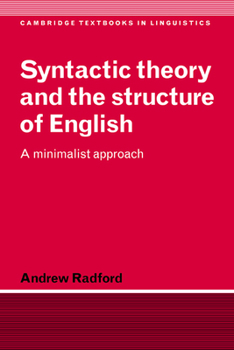Syntactic Theory and the Structure of English: A Minimalist Approach
(Part of the Cambridge Textbooks in Linguistics Series)
Select Format
Select Condition 
Book Overview
Andrew Radford's textbook is written for students with little or no background in syntax, and introduces them to key concepts of Chomsky's minimalist programme (e.g. merger and movement, checking,... This description may be from another edition of this product.
Format:Paperback
Language:English
ISBN:0521477077
ISBN13:9780521477079
Release Date:August 1997
Publisher:Cambridge University Press
Length:572 Pages
Weight:2.00 lbs.
Dimensions:1.2" x 6.1" x 9.1"
Customer Reviews
1 rating
A Very Good Primer on Current Syntax
Published by Thriftbooks.com User , 23 years ago
For the most part, Andrew Radford's book does an excellent job of bringing someone new to the nuances of syntactic theory up to speed. As someone with only a general background in the field (but also posessing a deep love of syntactic theory), I consider myself to be a very good test subject.One of the book's strongest points is Radford's willingness to take the time and space necessary to explain each detailed step in a theory, derivation, etc. Although I did not need all of the detail all of the time, it was easy to skip those parts and move on. For those with VERY little background in syntactic theory, these carefully outlined steps will be quite helpful in understanding where Radford is taking the theories.Another item of importance is Radford's occasional display of alternate explanations for certain empirical paradigms. Although even more alternates would have been more satisfying to me, too many would have made the 550-page book too cumbersome for some.A third strong point for the book is its generous workbook sections, one for each chapter. In each section, the problems are carefully explained, and the examples are arranged in an order of progressive difficulty. By using the workbook sections, the student can much better grasp the ideas than by simply going over the chapter's supplied paradigms/answers.There are, however, a few drawbacks to be kept in mind. First, only the initial (and easiest) of the workbook section's problems typically is given an answer. For a student doing independent study (like me), or for one with a teacher who is inattentive to the workbook section, this poses a major problem in that difficulties cannot be easily rectified. To make matters more confusing, a few of the workbook problems address issues which are not directly commented on in the chapter.The other problem I noticed was the book's espousing certain ideas without any explanation thereof. For instance, the book subscribes to the binary merger theory but offers no real reasons for it (and also neglects to offer any current alternatives). This is not an argument against binary merger; I simply maintain that it would have been better for the reader to understand (even very basically) the author's reasoning behind this decision.Despite these two problems, however, I highly recommend this text to anyone wishing to enter into the academic world of theoretical syntax and explore many of its nuanced facets.





